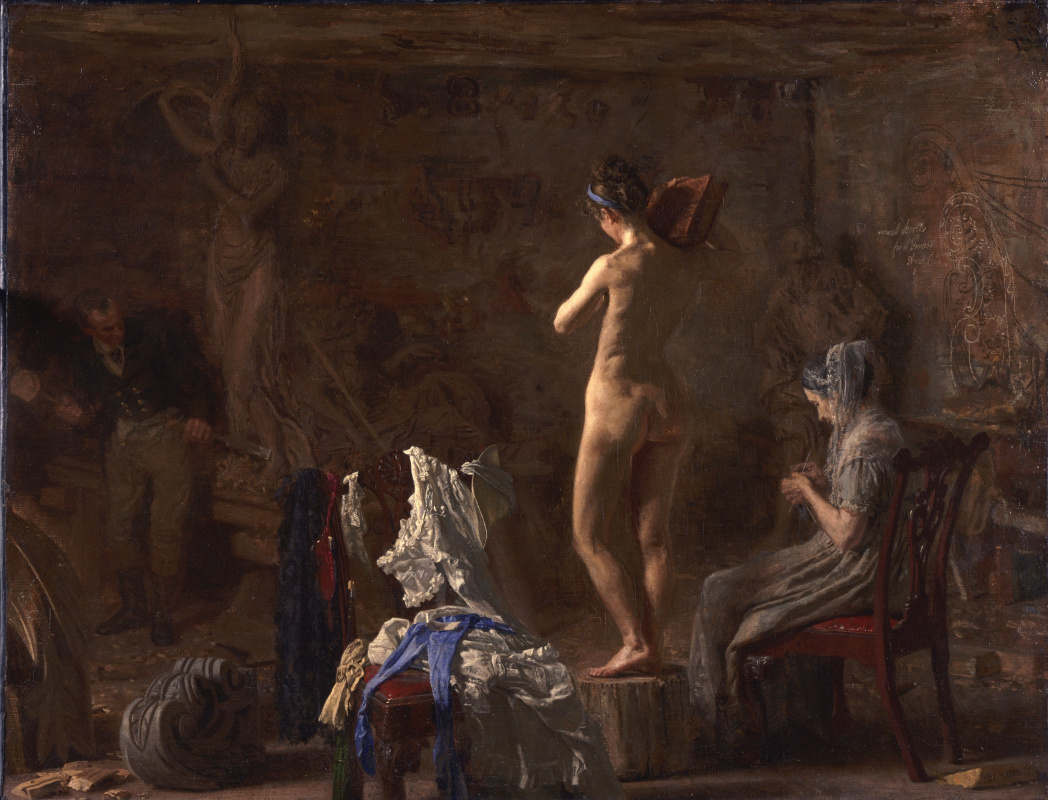log in
Enter site
Login to use Arthive functionality to the maximum
William rush and his model (William rush cuts allegorical figure of the Schuylkill river)
Thomas Eakins • Painting, 1877, 51.1×66.4 cm
Description of the artwork «William rush and his model (William rush cuts allegorical figure of the Schuylkill river)»
In 1808 the authorities of Philadelphia commissioned famed sculptor William rush sculpture, which was supposed to be part of the first fountain in the city and to mark the beginning of work of the centralized water supply. Rush, who among other things was engaged in the manufacture of wooden shapes for nose parts of the ships, cut out of pine beautiful nymph (she was to symbolize the Schuylkill river, Philadelphia to supply drinking water) holding on the shoulder of the bittern. The figure was painted white to simulate the marble and installed the fountain in the Central square of the city. Nearly 70 years later Thomas Eakins chose to depict the rush at work on a sculpture to immortalize his name in the history of American art. In 1877, the artist finished work on the first of a series of paintings under the name of "William rush and his model".
He is a teacher at the Academy of fine arts of Pennsylvania (one of the founders of which, incidentally, was William rush), Eakins has repeatedly argued that students need to study anatomy and to write Nude models to better understand the workings of the human body. It is doubtful that the rush to work on your sculpture is completely stripped model, but Eakins chose to depict this scene in accordance with their beliefs. In addition, the artist made a historical inaccuracy, by placing the Studio in the rush of the sculptures that were created later nymphs with drink on the shoulder.
The artist has created numerous preliminary sketches on canvas and paper, and also cut out some shapes out of wax, which are still preserved in the Philadelphia Museum of art. The final version of the painting was first exhibited at the Boston art club in January 1878 and later that year in the Society of American artists in new York. Like many of Eakins's work, the painting "William rush and his model" has caused much controversy and criticism. Oddly enough, the public was outraged not fully naked girl, but... her clothes, haphazardly dumped on the chair. One of the new York reviewers wrote that it "shocking the viewer and makes him think about nudity, and it makes the film obscene".
Eakins returned to rush, and the nymph in 1808 (probably in honor of the centennial of the creation of the sculpture). The artist painted two versions of the canvas. On the groundhe changed the composition by placing companion girls between the model and the sculptor, and getting rid of "outrageous" mountain of clothes. The second picturewritten in the same year, depicts a girl facing the audience, and rush is holding her hand, helping down from the dais.
Author: Eugene Sidelnikov
He is a teacher at the Academy of fine arts of Pennsylvania (one of the founders of which, incidentally, was William rush), Eakins has repeatedly argued that students need to study anatomy and to write Nude models to better understand the workings of the human body. It is doubtful that the rush to work on your sculpture is completely stripped model, but Eakins chose to depict this scene in accordance with their beliefs. In addition, the artist made a historical inaccuracy, by placing the Studio in the rush of the sculptures that were created later nymphs with drink on the shoulder.
The artist has created numerous preliminary sketches on canvas and paper, and also cut out some shapes out of wax, which are still preserved in the Philadelphia Museum of art. The final version of the painting was first exhibited at the Boston art club in January 1878 and later that year in the Society of American artists in new York. Like many of Eakins's work, the painting "William rush and his model" has caused much controversy and criticism. Oddly enough, the public was outraged not fully naked girl, but... her clothes, haphazardly dumped on the chair. One of the new York reviewers wrote that it "shocking the viewer and makes him think about nudity, and it makes the film obscene".
Eakins returned to rush, and the nymph in 1808 (probably in honor of the centennial of the creation of the sculpture). The artist painted two versions of the canvas. On the groundhe changed the composition by placing companion girls between the model and the sculptor, and getting rid of "outrageous" mountain of clothes. The second picturewritten in the same year, depicts a girl facing the audience, and rush is holding her hand, helping down from the dais.
Author: Eugene Sidelnikov


